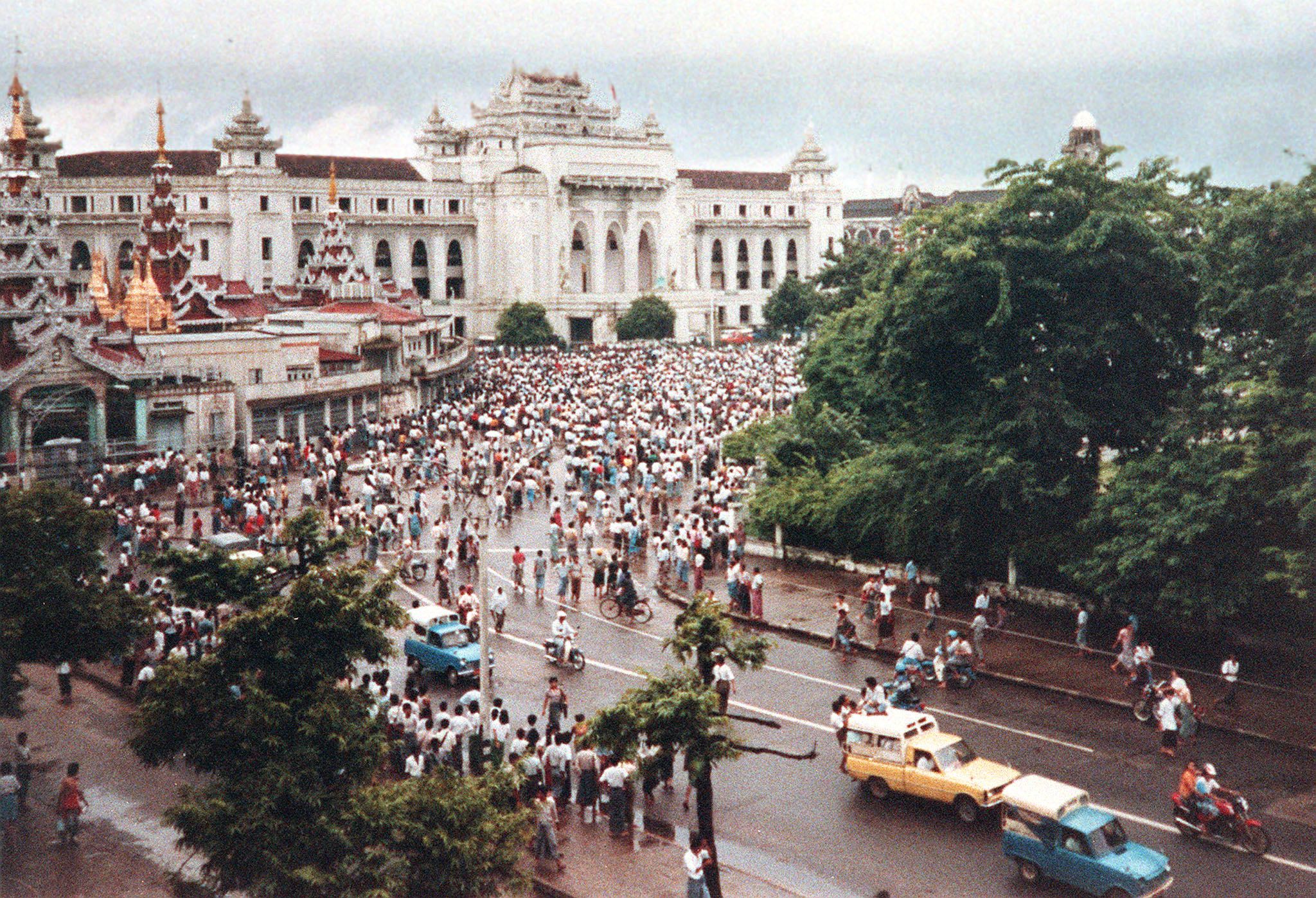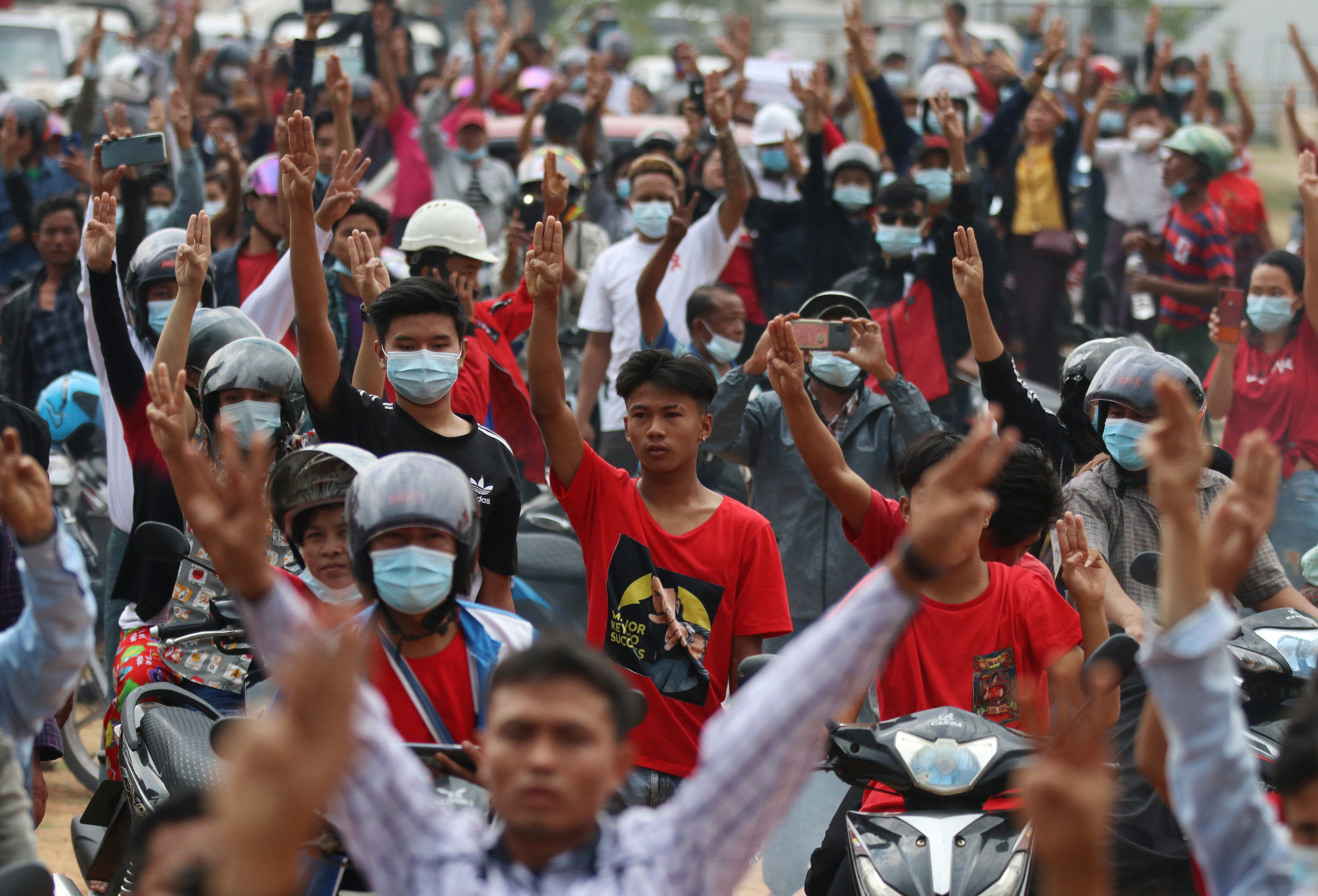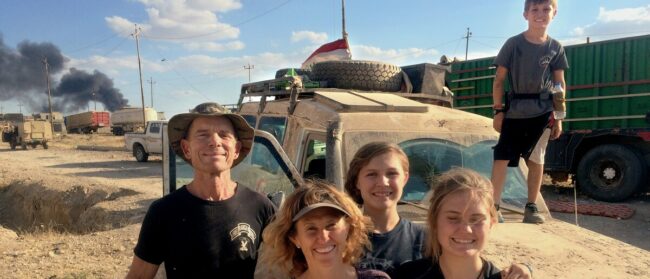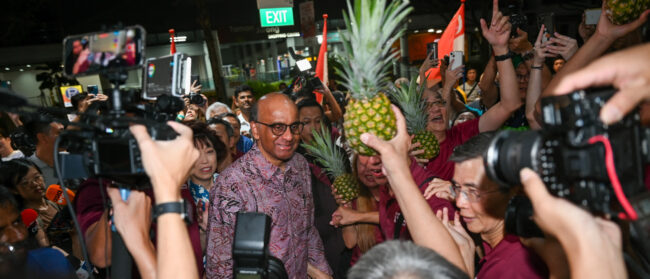Over the weekend, Myanmar’s streets were once again filled with protestors, chanting in opposition to the recent military coup and waving red flags adorned with the dancing peacock, a long-standing symbol of democracy in the country.
For many young people on the frontlines today, this is their first time facing overt military rule, with the election of Aung San Suu Kyi’s civilian government in 2015 putting an end to the junta regime. But among their ranks are seasoned activists, particularly those who led the charge against the military during deadly protests in 1988.
While today’s protestors face a vastly different world to that of their predecessors, in which social media activism has become central to organisation efforts, they are staring down an old foe, drawing knowledge and tactics from past movements.
This is a consideration the junta seems conscious of, with many of the leading activists from the 1988 demonstrations – known as the 8888 Uprisings for the date on which they culminated, August 8, 1988 – preemptively targeted during the February 1 raids that initiated the military’s most recent power grab.
“For a lot of people who went through, or are familiar with, the 1988 uprising or the coup, they knew that [arrests] were something that would happen,” explained Wai Hnin Pwint Thon, who works with Burma Campaign UK and is the daughter of former 8888 activist U Mya Aye who was detained last week. “When [activists] heard rumours about the coup, they were very aware that they might be arrested.”
Mass arrests are meant to send a message of fear, a message that the military can do what it wants, when it wants
U Bo Kyi, a participant in the 8888 Uprisings who was subsequently imprisoned in 1989 for his involvement, now serves as the joint secretary for the Assistance Association for Political Prisoners (AAPP) in Myanmar. He explains that the Tamadaw’s tactic of using mass arrests, both in 1988 and today, are an effort to incite panic among activists.
“Mass arrests are meant to send a message of fear, a message that the military can do what it wants, when it wants,” explained Bo Kyi. “If this military coup is allowed to succeed, people’s fundamental human rights will be restricted, and dissidents persecuted.”
The 8888 Uprisings were staged in response to a decades-long, military-led socialist agenda that impoverished large portions of the population, coming to a head in the late 1980s when a series of destabilising economic reforms wiped out student savings overnight, prompting protests against the junta at universities across Yangon.
Mya Aye, one of the 8888 student leaders, was first arrested in 1989 and sentenced to eight years in prison. He was released in 1996 but subsequently arrested in 2007 during that year’s Saffron Revolution. Since his release in 2012, as part of a mass presidential pardon for political prisoners, he has been an outspoken advocate for human rights and democracy across Myanmar.
During the February 1 coup, Mya Aye was taken from his home in Yangon before sunrise and has not been heard from since, according to daughter Wai Hnin.
“He was taken at 5:30 in the morning on Monday, and in the afternoon two military personnel came to our house to collect more clothes so it indicates that he will be there for a while,” Wai Hnin told the Globe. “Since [his arrest] we haven’t been contacted, we have no idea where he is, or where other activists are.”
Mya Aye missed Wai Hnin’s birth and infancy while he was in prison. When she finally met her father, it was through prison bars. This time, Wai Hnin is similarly unsure of when she will next hear from her father. The circumstances in Myanmar prisons are notoriously inhumane, and without communication or ample media attention, she has no way of knowing where he is or how he’s being treated.
“A lot of the news we’ve seen is about the NLD [National League for Democracy] and Aung San Suu Kyi. Not many talked about the activists being arrested, and we have no idea where they are nor their conditions,” said Wai Hnin.

As jolting as the pre-dawn raid and subsequent military crackdowns have been, Wai Hnin is not alone in her suffering. Many families across the country are facing similar circumstances as an increasing number of activists are targeted, with the Assistance Association for Political Prisoners reporting 164 arrests (with 152 still under detention) as of publishing.
While a portion of those arrested were detained during the initial coup, other arrests were reported in the days that followed, likely in anticipation of possible resistance efforts that have already begun to materialise.
On Saturday (February 6), demonstrators across Myanmar took to the streets to denounce the tatmadaw and call for the release of Suu Kyi. Upwards of 10,000 people were seen in Yangon, carrying banners and raising the three-finger salute, a sign that has come to represent anti-authoritatian sentiment in Thailand in recent months.
This number would increase exponentially on Sunday (February 7) as hundreds of thousands of protestors gathered, chanting various pro-democracy slogans as bystanders cheered them on.
With these mass protests taking form, there’s an inclination to draw parallels between present and the past – particularly the 8888 Uprisings, with some protestors adopting similar calls for unity. Videos posted on Facebook and Twitter late last week showed peaceful protestors singing the song Kabar Makyay Bu (We Won’t be Satisfied Until the End of the World) – the same song that was sung as an anthem through the protests in 1988.
But while there are lessons to be learned from the 8888 Uprisings, the recent coup in Myanmar, and subsequent opposition efforts, cannot be reduced to a historical recurrence.
Those flooding the streets in Myanmar today come from a digital generation that have been emboldened by the glimpse of democratic possibility under five years of governance by the now-ousted NLD. These activists are young and connected, and are operating within a decentralised organisation, becoming known across the country as the Civil Disobedience Movement.
While the 8888 Uprisings were similarly organised by young student activists, for those who were not immediately involved in the demonstrations there was a twofold sense of indifference towards political engagement and fear of military retribution.
“This time around, we see a lot of younger generations, a lot of people in their teenage years or even 20s [engaging] – this is their first time witnessing it,” said Wai Hnin.
Myo Min, a leader from the 8888 Uprisings, now the Executive Director of Equality Myanmar, explained that while today’s youth have learned from the older generation of activists like himself, there is a greater awareness in how to galvanise effective opposition efforts that can bring about meaningful and sustainable change.
“The Civil Disobedience Movement lets the people know that they have the power to act individually,” Myo Min explained. “They’ve learned – not only to go out on the street – but that there are other ways that people can take action and express their dismay against the military coup.”
One of these novel forms of activism is the use of boycotts, with a growing number of efforts to protest military activity through individual action.
“In the past few days, we’ve seen all these administrative officials – doctors, engineers, teachers, refusing to show up [for work],” said Htet Thiha Zaw, a Burmese PhD candidate in political science and government at the University of Michigan. “Even people from the Department of Revenue have refused to collect taxes.”
There are also surveys and news campaigns circulating online that call attention to military-owned companies, such as Mytel, a service provider, and Red Ruby, a brand of cigarettes, and encourage public boycotts of these enterprises to reduce the military’s economic support.

Another distinguishing feature of current protests is the absence of a singular, decisive leader, says Thinzar Shunlei Yi, a prominent civil activist currently working at the forefront of the Civil Disobedience Movement. She explained that today’s leaders are putting an end to personality politics – where the success of a movement hinges on the actions of one person.
“This time, everyone turns out to be an activist. This is something different from the past, we don’t have a leader anymore,” explained Shunlei.
In 1988, Aung San Suu Kyi became central to the anti-military efforts and was revered as a pivotal figure behind which the pro-democracy movement rallied. Though Suu Kyi lost international credibility through her cooperation with the Tatmadaw, including seemingly defending its mass violence against the Rohingya, she remains a popular leader at home atop the NLD.
Military police detained both Suu Kyi and Myanmar President Win Myint during the coup, leaving their absence notable in the ongoing protests. Their swift arrests have provided a lesson to a new generation of activists, with Shunlei saying that everyone in these current protests is empowered to participate and lead.
“We see ourselves as leaders, to lead something by ourselves. We feel as though our voice is powerful.”
The onset of the internet and social media has helped to facilitate this rise in egalitarian organisation. Now, thanks to platforms like Facebook and Twitter, groups can coordinate and mobilise much more quickly, as well as readily share information with the international community.
Young activists have learned a lot, they are more upgraded and expert on using social media. They’ve learned this, not from our generation, but from other countries, like the student movement in Hong Kong
Drawing inspiration from protests in other countries, this increased connectivity, which is still relatively new to Myanmar with internet access only becoming widespread following the 2015 elections, also distinguishes the current crop of protestors from their 8888 predecessors.
“[Young activists] have learned a lot, they are more upgraded and expert on using social media,” explained Myo Min. “They’ve learned this, not from our generation, but from other countries, like the student movement in Hong Kong.”
The prominence of these digitised forms of news-sharing at once increase the expediency as well as the vulnerability of opposition efforts. On Saturday, following Yangon’s protests, the military capitalised on this dependency by shutting down all internet access in an effort to deter the resistance effort.
Earlier in the week, the Tatmadaw had similarly implemented a social media ban, preventing access to key information hubs like Facebook. In response, young people throughout the country downloaded VPNs to ensure that lines of communication would stay open, even showing their parents and grandparents how to do the same.
However, on Sunday, despite the military’s efforts, upwards of 200,000 took to the streets in cities all across Myanmar in a mass demonstration of unity and democratic solidarity.
“Young people are organising themselves, migrating to Twitter to tweet about what’s going on, to try their best to get the word out of the country and inform the international community about what’s happening,” said Shunlei.
As activists across Myanmar prepare for another week of protests against the newly-instated military regime, many are encouraged by the scale of the demonstrations and the scope of engagement.
During some of the protests in Yangon, demonstrators were seen offering the military food and water, and even bestowing them with red roses. In a series of powerful images posted on Twitter on Sunday evening, it appears as though these appeals, at least individually, could be working. In the photographs, several military personnel and police officers – many of whom had barricaded the streets hours earlier – can be seen holding up the same three-finger salute in solidarity with the protestors.
While the return of a military government in Myanmar has ushered in a wave of uncertainty, the opposition movement, particularly its young demographic, is bringing hope to many. Wai Hnin, in particular, has found solace in seeing how many young people have been shaken out of their political apathy and are joining the resistance.
“It’s a good encouragement to see a lot of younger people are now engaging with the Burmese politics and showing interest in what’s going on in the country,” explained Wai Hnin. “If you want to look at one good thing out of this whole picture, I would take it that way.”


